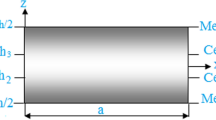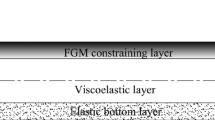Abstract
A hyperbolic shear deformation theory is proposed to investigate the bending analysis of inhomogeneous elastic/viscoelastic/elastic (EVE) sandwich plates. The sandwich plate is consisting of two elastic material faces and viscoelastic material core. Three kinds of symmetric sandwich plates that are classified depending on thickness of each layer are presented. A fourth type of sandwich plate is considered without viscoelastic core. The equilibrium equations have been solved by using Illyushin’s approximation method as well as the effective moduli method. The deflection and stresses of simply supported EVE sandwich plates have been presented due to a hyperbolic theory and compared with those due to other familiar plate theories. The effect of different parameters on bending analysis of sandwich plates is discussed.













Similar content being viewed by others
References
Plantema FJ (1966) Sandwich construction. Wiley, New York
Whitney JM (1987) Structural analysis of laminated anisotropic plates. Technomic, Lancaster
Vinson JR (1999) The behavior of sandwich structures of isotropic and composite materials. Technomic, Lancaster
Reissner E (1947) On bending of elastic plates. Q Appl Math 5:55–68
Hoff NJ (1950) Bending and buckling of rectangular sandwich plates. NACA TN 2225, Nov
Reissner E (1945) The effect of transverse shear deformation on the bending of elastic plates. J Appl Mech 12(2), Trans ASME 61:69–77
Mindlin RD (1951) Influence of rotatory inertia and shear on flexural motions of isotropic elastic plates. J Appl Mech 18:31–38
Yang PC, Norris CH, Stavsky Y (1966) Elastic wave propagation in heterogeneous plates. Int J Solids Strut 2:665–684
Reissner E (1985) Reflection on the theory of elastic plates. Appl Mech Rev 38:1453–1464
Noor AK, Burton WS (1989) Refinement of higher-order laminated plate theories. Appl Mech Rev 42:1–13
Reddy JN (1990) A review of refined theories of laminated composite plates. Shock Vib Dig 22:3–17
Pagano NJ (1970) Exact solutions for rectangular bidirectional composite and sandwich plates. J Compos Mater 4(1):20–34
Zenkour AM (2007) Three-dimensional elasticity solution for uniformly loaded cross-ply laminates and sandwich plates. J Sand Strut Mater 9(3):213–238
Pagano NJ, Hatfield SJ (1972) Elastic behaviour of multilayered bidirectional composite. AIAA J 10(12):931–933
Noor AK, Peters JM, Burton WS (1994) Three-dimensional solutions for initially stressed structural sandwiches. J Eng Mech ASCE 120(2):284–303
Zenkour AM (2005) A comprehensive analysis of functionally graded sandwich plates: part 1—deflection and stresses. Int J Solids Strut 42(18–19):5224–5242
Zenkour AM (2005) A comprehensive analysis of functionally graded sandwich plates: part 2—buckling and free vibration. Int J Solids Strut 42(18–19):5243–5258
Hildebrand FB, Reissner E, Thomas GB (1949) Note on the foundations of the theory of small displacements of orthotropic shells. NACA TN-1833
Nelson RB, Lorch DR (1974) A refined theory for laminated orthotropic plates. ASME J Appl Mech 41:177–183
Librescu L (1975) Elastostatics and kinematics of anisotropic and heterogeneous shell type structures. Noordhoff, Groningen
Lo KH, Christensen RM, Wu EM (1977) A high order theory of plate deformation, part 1: homogeneous plates. ASME J Appl Mech 44(4):663–668
Christensen RM, Lo KH, Wu EM (1977) A high order theory of plate deformation, part 2: laminated plates. ASME J Appl Mech 44(4):669–676
Murthy MV (1981) An improved transverse shear deformation theory for laminated anisotropic plates. NASA Technical 1981:1903
Reddy JN (1984) A simple higher-order theory for laminated composite plates. J Appl Mech 51:745–752
Khdeir AA, Reddy JN (1989) Exact solutions for the transient response of symmetric cross ply laminates using a higher order plate theory. Compos Sci Technol 34(3):205–224
Zenkour AM (2018) A quasi-3D refined theory for functionally graded single-layered and sandwich plates with porosities. Compos Struct 201:38–48
Reddy JN, Barbero EJ, Teply JL (1989) A plate bending element based on a generalized laminate plate theory. Int J Numer Mech Eng 28:2275–2292
Reddy JN, Khdeir AA (1989) Buckling and vibration of laminated composite plates using various plate theories. AIAA J 27(12):1808–1817
Reddy JN (2000) Analysis of functionally graded plates. Int J Numer Methods Eng 47(1–3):663–684
Zenkour AM (2006) Generalized shear deformation theory for bending analysis of functionally graded plates. Appl Math Model 30(1):67–84
Zenkour AM (2009) The refined sinusoidal theory for FGM plates on elastic foundations. Int J Mech Sci 51(11–12):869–880
Soldatos KP (1992) A transverse shear deformation theory for homogeneous monoclinic plates. Acta Mech 94:195–220
Soldatos KP, Timarci T (1993) A unified formulation of laminated composite, shear deformable, five-degrees-of-freedom cylindrical shell theories. Compos Strut 25(1–4):165–171
Neves AMA, Ferreira AJM, Carrera E et al (2011) Bending of FGM plates by a sinusoidal plate formulation and collocation with radial basis functions. Mech Res Commun 38:368–371
Neves AMA, Ferreira AJM, Carrera E et al (2012) A quasi-3D sinusoidal shear deformation theory for the static and free vibration analysis of functionally graded plates. Compos B Eng 43:711–725
Neves AMA, Ferreira AJM, Carrera E, Cinefra M, Roque CMC, Jorge RMN, Soares CMM (2012) A quasi-3D hyperbolic shear deformation theory for the static and free vibration analysis of functionally graded plates. Compos Struct 94:1814–1825
Ranjbaran A, Khoshravan MR, Kharazi M (2014) Buckling analysis of sandwich plate using layerwise theory. J Mech Sci Technol 28(7):2769–2777
Maturi DA, Ferreira AJM, Zenkour AM, Mashat DS (2014) Analysis of sandwich plates with a new layerwise formulation. Compos B 56:484–489
Pandey S, Pradyumna S (2015) Free vibration of functionally graded sandwich plates in thermal environment using a layerwise theory. Eur J Mech A/Solids 51:55–66
Rakočević M, Popović S, Ivanišević N (2017) A computational method for laminated composite plates based on layerwise theory. Compos B 122:202–218
Xing YF, Wu Y, Liu B, Ferreira AJM, Neves AMA (2017) Static and dynamic analyses of laminated plates using a layerwise theory and a radial basis function finite element method. Compos Struct 170:158–168
Whitney JM, Pagano NJ (1970) Shear deformation in heterogeneous anisotropic plates. J Appl Mech Trans ASME 37(4):1031–1036
Bert CW (1973) Simplified analysis of elastic shear factors for beams of non-homogeneous cross-section. J Compos Mater 7:525–529
Reissner E (1991) A mixed variational equation for a twelfth-order theory of bending of nonhomogeneous transversely isotropic plates. Comput Mech 7(5–6):255–260
Reissner E (1994) On the equations of an eighth-order theory of nonhomogeneous transversely isotropic plates. Int J Solids Strut 31(1):89–96
Fares ME, Zenkour AM (1999) Buckling and free vibration of non-homogeneous composite cross-ply laminated plates with various plate theories. Compos Strut 44(4):279–287
Zenkour AM, Fares ME (1999) Non-homogeneous response of cross-ply laminated elastic plates using a higher-order theory. Compos Strut 44(4):297–305
Hashin Z (1965) Viscoelastic behavior of heterogeneous media. J Appl Mech Trans ASME 32:630–636
DiTaranto RA (1965) Theory of vibratory bending for elastic and viscoelastic layered finite-length beams. ASME J Appl Mech 32:881–886
Mead DJ, Markus S (1969) The forced vibration of a three-layer, damped sandwich beam with arbitrary boundary conditions. J Sound Vib 10:163–175
Douglas BE, Yang JCS (1978) Transverse compressional damping in the vibratory response of elastic–viscoelastic beams. AIAA J 16:925–930
Wilson DW, Vinson JR (1984) Viscoelastic analysis of laminated plate buckling. AIAA J 22:982–988
Kim CG, Hong CS (1988) Viscoelastic sandwich plates with cross-ply faces. J Strut Eng 114:150–164
Huang NN (1994) Viscoelastic buckling and post buckling of circular cylindrical laminated shells in hygrothermal environment. J Mar Sci Technol 2:9–16
Pan H (1966) Vibrations of viscoelastic plates. J de Mécanique 5:355–374
Librescu L, Chandiramani NK (1989) Dynamic stability of transversely isotropic viscoelastic plates. JSound Vib 130:467–486
Zenkour AM (2004) Buckling of fiber-reinforced viscoelastic composite plates using various plate theories. J Eng Math 50:75–93
Zenkour AM (2004) Thermal effects on the bending response of fiber-reinforced viscoelastic composite plates using a sinusoidal shear deformation theory. Acta Mech 171:171–187
Allam MNM, Zenkour AM, El-Mekawy HF (2010) Bending response of inhomogeneous fiber-reinforced viscoelastic sandwich plates. Acta Mech 209:231–248
Zenkour AM (2011) Bending responses of an exponentially graded simply supported elastic/viscoelastic/elastic sandwich plate. Acta Mech Solida Sin 24(3):250–261
Zenkour AM (2012) Viscoelastic analysis of an exponentially graded sandwich plate. J Mech Sci Technol 26(3):889–898
Zenkour AM, El-Mekawy HF (2014) Bending of inhomogeneous sandwich plates with viscoelastic cores. J Vibroeng 16(7):3260–3272
Pobedrya E (1976) Structural anisotropy in viscoelasticity. Polym Mech 12(4):557–561
Illyushin A, Pobedria BE (1970) Foundations of mathematical theory of thermo viscoelasticity. Nauka, Moscow (in Russian)
Author information
Authors and Affiliations
Corresponding author
Ethics declarations
Conflict of interest
The authors declare that they have no conflict of interest.
Additional information
Technical Editor: Paulo de Tarso Rocha de Mendonça.
Appendices
Appendix 1
Appendix 2
The functions \(\pi \left( t \right)\) and \(g_{{\mu_{m} }} \left( t \right)\) may be derived by deducing Laplace–Carson transform of these functions from known Laplace–Carson transform of function \(\omega \left( t \right)\) as
using Eq. (28), one gets
then by integrating the above function, we get
but we have
then
or
where
So, \(\pi \left( t \right)\) can be obtained by using inverse Laplace–Carson as
Similarly,
or
where \(\mu_{1} = \frac{1}{2}\) and \(\mu_{2} = 2\). So,
in which
and then \(g_{{\mu_{m} }} \left( t \right)\) may be obtained in its final form as
Rights and permissions
About this article
Cite this article
Zenkour, A.M., El-Mekawy, H.F. Stresses in inhomogeneous elastic–viscoelastic–elastic sandwich plates via hyperbolic shear deformation theory. J Braz. Soc. Mech. Sci. Eng. 40, 363 (2018). https://doi.org/10.1007/s40430-018-1284-4
Received:
Accepted:
Published:
DOI: https://doi.org/10.1007/s40430-018-1284-4




